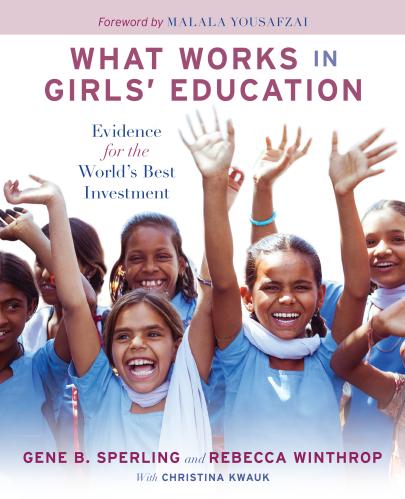This report is part of a series of essays by the Global Economy and Development program—a 10th anniversary edition. The series, available here, delves into the critical issues facing all those concerned about globalization. You can join the conversation on Twitter using #11GlobalDebates.
1.1 What’s the issue?
At no point in history have more children been enrolled in formal education. Thanks to global commitments and movements such as the Millennium Development Goals and Education For All, more than 90 percent of all primary-age children are now in school.
But efforts to expand children’s education have served to obscure the surreptitious rise of a global learning crisis. An estimated 650 million children have not reached foundational developmental and learning milestones: 200 million under the age of five are not meeting basic socio-emotional and cognitive growth indicators; 250 million (half of whom are in school) lack basic literacy or math skills; and another 200 million youth do not possess the basic set of literacy and numeracy skills they will need for work.
Education and the acquisition of skills are crucial to solving some of the world’s most pressing problems. Education is a basic right that promotes other rights such as health and civic participation. It is key to unlocking the developmental potential of children, communities, and countries. An educated workforce can help lift people out of poverty, reduce premature mortality, strengthen gender equality, and promote civic participation. Children must also learn skills that can be flexible and adaptable in the age of uncertainty and economic change. Workers will need breadth of skills such as literacy and numeracy as well as the ability to think critically and to solve problems collaboratively. In the digital age, citizens must be prepared to respond to the challenges presented by globalization, climate change, health epidemics, and economic uncertainty.
The world needs to urgently rethink the way education is done, how it is delivered, and what skills children will need in a digital age to become healthy and productive members of society.
1.2 What’s the Debate?
Many agree that the delivery of education to marginalized children must be improved. However, there is little consensus on how to do so in a way that best reflects the challenges and opportunities facing young people today and on why education systems have largely failed to adapt to ensure that all children are receiving the support and learning opportunities they need. Responses to the global learning crisis will need to account for three key questions.
1.2.1 First, what should children learn?
There is a growing disjuncture between what children are expected to learn and the types of job opportunities that will be available for them. Take sub-Saharan Africa and South Asia, where a surge in the youth population will make it likely that, among the low-skilled workers entering the job market by 2020, 58 million new entrants will be in “surplus” – in other words, unwanted. On the flipside, these regions are projected to face a deficit of 44 million skilled workers. Further, according to the largest employer survey of developed and developing countries alike, many employers are struggling to find talent with adequate “workplace competencies” like teamwork, problem solving, and communication. Young people must be equipped to adapt to a changing workforce and to contend with the modernization of routinized work. Even some “thinking jobs,” such as accounting or advanced assembly line work in the manufacturing sector, are becoming automated. In its place, employers will be seeking out a workforce possessing analytical and interpersonal skills.
650 million—The number of children globally who have not reached key developmental and learning milestones.
1.2.2 Second, how can education reduce disparities?
It is the right of all children to receive learning opportunities that can provide them with the breadth of skills they need to become healthy, productive members of society. Yet, education inequalities persist, as evidenced by the 100 year gap between developed and developing regions with respect to education completion and learning outcomes. There is also growing education inequality within countries. The good news is that there is renewed global consensus to improve equity. The United Nations Sustainable Development Goals, adopted by the 193 countries of the U.N. General Assembly in September 2015, calls for concerted actions to help children and youth develop the skills they need from early childhood through adolescence.
100 years—that’s how long the gap is between education levels in developed and developing countries.
1.2.3 Third, how should education systems be set up to deliver skills in the digital age?
The case can be made that children are not learning the skills they need, at least in part because the conventional approaches to delivering education are not effective for fostering breadth of skills. One central aspect of this debate is how best to apply technology to learning and practice. Increased connectivity is changing how knowledge is transmitted. Libraries are being digitized. Classes and course materials once accessible only to the rich or well-connected are now within reach via a smartphone. Yet in schools, technology has largely failed to systematically transform the teaching and learning environment.
2 billion is the number of people untouched by digital technologies.
A recent study in U.S. schools shows that this is largely because technology still functions more or less like an expensive substitute for textbooks and chalkboards. New advances in technology and artificial intelligence hold potential to provide mass personalization and foster engaging learning environments, but this will require reorganizing classrooms and capitalizing on the time young people spend outside school.
While low-cost devices like mobile phones have reached many, today almost 2 billion people remain untouched by digital technology, making it clear that connectivity is neither a panacea for solving the global learning challenge, nor should it be a top education priority.
1.3 What to watch out for?
Education systems in many countries, high- and low-income alike, have failed to adequately provide skills children will need in the digital age. There are several ways to infuse change into education systems.
1.3.1 Breadth of skills is a key for addressing the skills gap.
The new demands of societies require cultivating breadth of skills, which refers to a range of important skills and tasks including the basics that many education systems currently focus on (the “three Rs”); but it also prioritizes the need to develop information literacy, flexibility, and collaborative problem solving. Cultivating breadth of skills will not be achieved by adding additional content or subjects to the curriculum. Rather, it requires a different way of teaching the academic subjects already prioritized in any given country’s curriculum. In this way, young people can master subject-matter content and breadth of skills simultaneously.
1.3.2 If children are going to receive the breadth of skills, education must be delivered in a way that is dynamic, relevant, and applied.
The link between applied, hands-on learning and better developmental outcomes is grounded in science. But it also appeals to our common sense: children learn best when their brains are engaged. This approach diverts from the oft-distilled forms that we see in classrooms today, in which children are asked to ingest material through rote memorization and didactic pedagogy. What are needed instead are efforts to place the learner, rather than the institution (i.e., the school), at the heart of education system transformation. Applied and hands-on learning helps children resolve practical problems with real world relevance. For example, children could be asked the question, “Why does it rain?” But rather than memorize and recite a series of steps for how precipitation occurs, their teacher can ask them to work in groups to produce a report, which employs critical thinking skills, creativity, and teamwork to accomplish the task. They are well-suited to respond to real-world challenges in that they focus on integrating and linking complex challenges to real-life solutions.
1.3.3 Education systems must take the form of an inclusive and adaptive ecosystem.
While government ultimately bears the responsibility of ensuring that all children can exercise their right to a quality education, education is not solely a concern of ministries of education. Rather it is an ecosystem which consists of a constellation of government, civil society, and private sector actors that are engaged in educating children in a variety of contexts. Ecosystems must also foster an environment in which education adapts to the needs of society, where evidence is used to test new methods and improve, and where all actors, including children and their families, can effectively offer their expertise. The private sector, including non-profit as well as private and fee-paying schools, is playing an increasingly prominent role in the delivery of education in the developing world. Some are findings innovative ways to cut costs and improve outcomes. Yet, it remains the government’s duty to play the leading role to ensure that innovation occurs in a way that can improve equity— and not the opposite. These factors are key to developing a nimble system, able to adapt to whatever the future holds.
1.4 What’s next?
In the digital age, governments, teachers, parents, and children will need to adapt to the rapid advances in technology and major changes to the world of work to solve complex challenges. It is a disservice to children to proceed with a business as usual, incremental approach to improving schooling. Incremental improvements to failed education systems are insufficient to bring about the transformational shifts to curriculum and pedagogy that are needed to get better results. Simply put, in the age of Google, many country’s education systems are still based on the assumption of scarce information, which in the long run will spectacularly fail children. If all children are to receive the learning opportunities and breadth of skills that they need and deserve, transformational shifts to the way education is conceptualized and delivered must occur.
Such a shift is essential for the 193 countries striving to reach the global goal of ensuring quality education and lifelong learning for everyone by 2030.
193 countries have committed to support the Global Goal of ensuring quality education and promoting lifelong learning opportunities for all.





